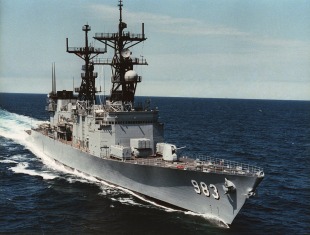Эсминец USS John Rodgers (DD-983)
Основная информация
Главные размерения
Машина
- 4 * General Electric LM2500 gas turbines
- 2 * shafts, 80,000 shp (60 MW)
Персонал
Боевые силы и средства
- AN/SPS-40 air search radar
- AN/SPG-60 fire control radar
- AN/SPS-55 surface search radar
- AN/SPQ-9 gun fire control radar
- Mark 23 TAS automatic detection and tracking radar
- AN/SPS-65 Missile fire control radar
- AN/SQS-53 bow mounted Active sonar
- AN/SQR-19 TACTAS towed array Passive sonar
- Naval Tactical Data System
- AN/SLQ-32 Electronic Warfare System
- AN/SLQ-25 Nixie Torpedo Countermeasures
- Mark 36 SRBOC Decoy Launching System
- AN/SLQ-49 Inflatable Decoys
- 2 * 5 in (127 mm) 54 calibre Mark 45 dual purpose guns
- 2 * 20 mm Phalanx CIWS Mark 15 guns
- 1 * 8 cell ASROC launcher (removed)
- 1 * 8 cell NATO Sea Sparrow Mark 29 missile launcher
- 2 * quadruple Harpoon missile canisters
- 2 * Mark 32 triple 12.75 in (324 mm) torpedo tubes (Mk 46 torpedoes)
- 2 * quadruple Armored Box Launcher (ABL) Mark 43 Tomahawk missile launchers
- 2 * Sikorsky SH-60 Seahawk LAMPS III helicopters
The USS John Rodgers (DD-983), a destroyer belonging to the Spruance-class, stood as the sixth vessel in the United States Navy honored in tribute to the three lineages of the Rodgers family who rendered service in the navy.
John Rodgers commenced its construction on August 12, 1976, at Ingalls Shipbuilding in Pascagoula, Mississippi. It underwent its launch on March 18, 1978, graced by Mrs. Roy C. Smith, Jr., the great, great-granddaughter of Commodore John Rodgers, and was officially commissioned on July 14, 1979.
During the early 1980s, under the command of Commander Wagner, John Rodgers traversed the Atlantic, Pacific, and Indian Oceans. The ship passed through both the Panama Canal and the Suez Canal. As part of U.S. policy, it entered the Persian Gulf to support Iraq during its conflict with Iran.
Crossing the equator en route to Kenya marked the initiation of «Pollywogs» (non-crossers) by the «Shellbacks» (crossers). This period saw John Rodgers making port calls across four continents, visiting Panama, Spain, Italy, France, Monaco, England, Germany, Finland, Denmark, Morocco, Egypt, Israel, Bahrain, and Kenya.
In a historic event on September 16, 1983, while off Lebanon, John Rodgers engaged in combat, utilizing its 5" guns against Syrian-controlled areas, becoming the first ship to deploy the 5" 54 caliber Mark 45 gun in actual combat. This gun has since become standard on U.S. naval combat ships and numerous others worldwide.
Shift in U.S. policy in September 1983 led to direct support of Lebanese Army forces. Alongside Virginia, John Rodgers fired 338 5-inch rounds in support of ongoing missions defending the strategically significant village of Suk El Gharb in Lebanon.
During a Mediterranean deployment in 1990, while off the coast of Israel, Iraq's invasion of Kuwait led John Rodgers to commence operations in support of Operation Desert Shield. The ship undertook patrols in the Mediterranean Sea and later in the Red Sea before completing its deployment.
In 1993, serving as the flagship for Commander, South Atlantic Force, during UNITAS XXXIV under Rear Admiral (lower half) Wirt R. Fladd, USN, John Rodgers engaged with various South American navies during a lengthy deployment, making goodwill port calls and crossing the equator.
In 1995, as part of the NATO Standing Naval Force Atlantic, John Rodgers conducted Maritime Interdiction Operations in the Adriatic Sea in support of Operation Sharp Guard, visiting several ports during the six-month cruise.
With the closure of Naval Station Charleston in 1995, John Rodgers shifted its homeport from Charleston, South Carolina, to Mayport, Florida, where it remained stationed.
Participating in joint exercises with the British Royal Navy and Royal Marines in Scotland in early 1996, John Rodgers also made port visits to Edinburgh, Scotland; Bremerhaven, Germany; and Amsterdam, Netherlands.
Engaging in New York City's fleet week on May 23, 1996, John Rodgers continued its operational engagements, participating in various exercises and port visits until its final deployment in October 1997. This marked the conclusion of the ship's active service, leading to its decommissioning and eventual scrapping.
The ship's emblem symbolized the extensive service of three generations of the Rodgers family, with each element reflecting the distinct contributions made by Commodore John Rodgers, Rear Admiral John Rodgers, and Commander John Rodgers II. The sea eagle depicted the ship's primary mission of detection and striking ability, and the three arrowheads symbolized both the ship's multifaceted capabilities and the combined naval service of three family members for whom the vessel was named.
- Комментарии
 ru
ru en
en uk
uk




 Военно-Морские Силы США
Военно-Морские Силы США Ingalls Shipbuilding
Ingalls Shipbuilding